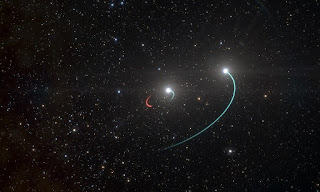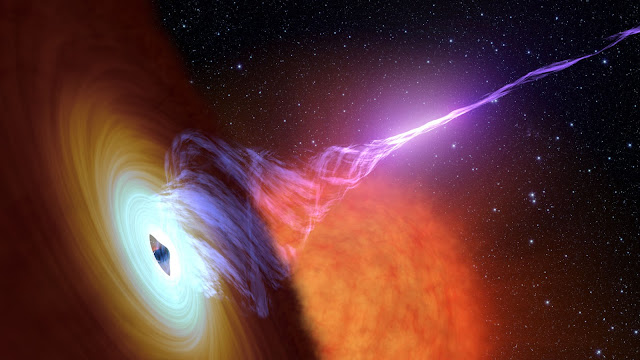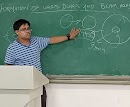Space Exploration
Newfound Black Hole is closest one to us….Is there any danger from it???
We all have seen
black holes engulfing and destroying Earth in science fiction movies. Perhaps,
the amount of destruction will be same as depicted…but, we should ask our-self
that: Is it possible for a black-hole to be situated so near to our Earth so
that it can cause catastrophic damage??? And if so, then which is the nearest
black hole to us and how far it is???
Well, probably for
the time beings, astronomers can’t answer the first question but luckily, now
they have the answer for the second one!!!
A newfound black
hole may be the closest black hole we have ever found and the most fascinating
thing about it is, you can spot its system in the night sky without a
telescope!!!...... Overwhelming right???
 |
| The blue dot in the middle of this picture is HR 6819 |
This black hole is
lurking 1011 light-years (about 9.5 thousand, million, million km) from Earth
in the southern constellation of Telescopium. This distance might sound not so
close, but on the scale of the universe, it’s just like next door. Until now,
the closest known black hole was one perhaps three times further away.
According to the
astronomers, this black hole was hiding in the ‘plain sight’. During winter in
the Southern Hemisphere, you can observe the system as a blue point of light.
This system of triple star system is named as HR 6819. Till now, it was
considered as a triple (living) star system, but after the discovery of this
black hole, the system consists of two living stars and one black hole.
 |
| Artist's depiction of HR 6819 system |
HR 6819 containing
a classical Be type star (designated as QV Tel B) having an unknown period, a
B3 star (designated as QV Tel Aa) and a non-emitting (non-accreting) black hole
having a mass of ≥5±0.4 M☉ and designated as QV Tel Ab. If you have been following my
articles on this website then you know that earlier I have discussed the formation of black holes and their natural behaviour. In that article, I
explained how violent black holes are. Almost all of them have an accretion
disk and their activities emit x-rays and gamma rays. By detecting those, we
can detect a black hole and you can see the radiation emitted by the black hole
in the first image of the black hole we have ever captured. But, in the case of HR
6819 the situation is totally different.
 |
| First picture of a black hole |
This black hole is ‘truly black’ since it doesn’t have
any accretion disk and thus don’t emit any such radiation. For this reason, we couldn’t
find this before. This was only discovered when astronomers observed that the
other two stars are circling around an unknown object.
Blackhole of HR 6819 is the first stellar-mass black hole that doesn’t actively interfere with its surroundings.
This black hole was discovered by the astronomers
from the European Southern Observatory and other institutes. The team found
evidence for the invisible object by tracking its two companion stars using the
MPG/ESO 2.2 metre telescope at ESO’s La Silla Observatory in Chile. This team originally
observed the system of HR 6819, as a part of a study of double-star systems.
Thomas Rivinus, an ESO scientist and
astronomer, who has led the project has said that an invisible object having
mass at least 4 times that of the sun can be nothing but a black hole.
The paper describing the discovery is published
in the journal of Astronomy and Astrophysics.
Astronomers have spotted few black holes in our
galaxy to date and nearly all of them strongly interact with their environment
and make their presence known by releasing powerful radiation like X-rays.
HR 6819 was
regarded as a single star until an astronomer named Monika Maintz find out that
the spectrum contained the signatures of two stars in 2009. The spectrum of
this system contains both narrow and broadened lines. The broad lines originate
from the (rapidly-rotating) ‘Be star’ and the narrow lines are from a more
slowly rotating B-class giant.
Researchers have long
speculated that the Milky Way is home of hundreds of millions of black holes which
are hiding in the darkness and now finally, their assumption is proving right.
But still, a question is left to ask….is there any danger from this particular
black hole???
Well...at least
for now, there is nothing worry about. But, who knows if someday, astronomers
will find another black hole which is even closer than this one!!!
To know basics of the quantum world, astronomy and space exploration you can check out my book "Through the wormhole" on amazon kindle.
You can directly talk with me on Instagram
To meet more physics Enthusiasts please join our Facebook Page
Also for the latest updates of my posts join me on TwitterTo meet more physics Enthusiasts please join our Facebook Page
Thanks for reading.....
See you next time!!!
-Ratnadeep Das Choudhury
Founder and Writer of The Dynamic Frequency













0 Comments